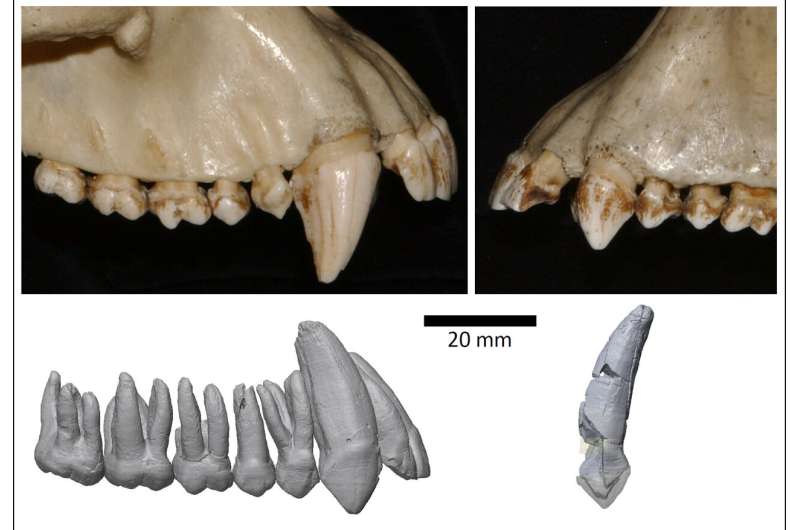Comparison of the upper canine teeth of a male common chimpanzee, Pan troglodytes (upper left), a female chimpanzee (upper right), a male A. ramidus (lower left), and a female A. ramidus (lower right). Credit: Gen Suwa.
A team of researchers led by Gen Suwa of the University of Tokyo has used statistical methods to calculate when canine teeth in modern male humans began to shrink down to their current size. In their paper published in Proceedings of the National Academy of Sciences, the group describes their study of hundreds of ancient fossil teeth.
Modern humans have the smallest canines of all anthropoids. They are also much smaller than those of the great apes. Researchers believe that modern male humans once had much larger canine teeth but they shrunk in size over time, possibly due to the reaction of females to overly aggressive males. In this new effort, the researchers sought to better understand when the shrinking process began.
To trace the history of the shrinking canines, the researchers collected and studied over 300 fossilized hominin teeth representing over 6 million years of evolution—24 of which were from Ardipithecus ramidus, which are some of the oldest known hominins. In looking at the teeth from A. ramidus, the researchers found they did not fall into two neat groups of big canines versus small canines. So the researchers applied statistical analysis to the variations they found in the teeth to trace canine size between males and females (canines in great apes are generally much smaller in females).
The researchers then applied their analysis technique to modern samples and found it to be quite accurate. Applying it to the ancient samples, the researchers found upper canines for male A. ramidus were approximately 1.06 bigger than the females, while the lower canines were approximately 1.13 times bigger. As a means of comparison, the researchers note that both upper and lower canines in modern chimpanzees are approximately 1.3 times larger in males than females.
The researchers then theorized that the differently sized canines between genders for A. ramidus was less than for modern bonobos, which have the lowest great ape canine gender difference. They suggest these findings indicate that canines in modern male humans likely began shrinking as far back as 4.5 million years ago. They further suggest that smaller canines were likely an indication of less aggression in males—a feature that could have evolved as females began to prefer to mate with males that were less aggressive.
More information: Canine sexual dimorphism in Ardipithecus ramidus was nearly human-like, Proceedings of the National Academy of Sciences (2021). DOI: 10.1073/pnas.2116630118.
Journal information: Proceedings of the National Academy of Sciences
© 2021 Science X Network
























